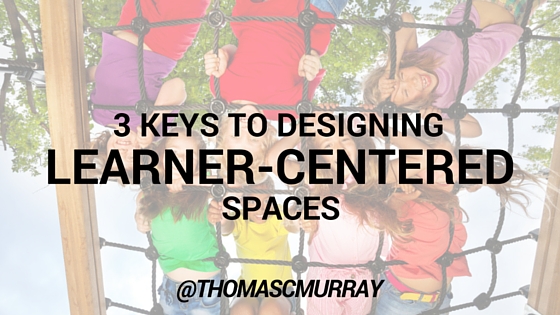3 Keys to Designing Learner-Centered Spaces
The average high school classroom, if drawn on a map, resembles a cemetery. Last summer, I co-authored a piece on “avoiding the cemetery effect” for this exact reason. Spaces are often set with desks in rows, students facing forward, with most of the action taking place in the first one-fifth of the room...by the teacher. I’ll humbly admit that this set up is the type of learning space I created for my fourth graders as an elementary teacher. I set the space up based on what was most convenient for me - not what was best for learning - for them. Although there is certainly a time and place for the teacher being front and center, many learning spaces remain almost completely teacher-centric, with little-to-no thought given to the brain research or learning theories as to how children learn best.
In the 1930s, Len Vygotsky’s research became the foundation for Social Development Theory, the understanding that social interaction plays a fundamental role in the development of cognition. Vygotsky strongly believed that community plays a central role in the process of “making meaning”. This notion is something that kindergarten and first grade teachers have mastered for years. As students get older and rise in grade levels, the notion that teachers ‘transmit knowledge’ for students to remember becomes more prevalent in today’s traditional educational structure and the role of play and interaction often becomes minimal at best.
Quite often we school the love of learning right out of kids by the time they graduate.
Listed below are three ways to create more learning-centric spaces.
1. Design Spaces for Collaboration.
Teachers that design learning-centered spaces create environments that facilitate collaboration. If we are truly going to ensure that students become “college and career ready”, we must help develop students that can work together, engage in respectful discourse, problem solve, and collaborate in both physical and virtual spaces. That world of work already exists. Our students must be prepared for what is yet to come - which undoubtedly yields a need for higher level problem solvers and collaborators, and not just with those sitting in the same room - but worldwide.
Learning spaces designed for collaboration have flexible seating arrangements, comfortable furniture, and are agile enough to be reworked in a short time period. Collaborative groups may go from only a handful of students to larger groups in only a short time period. These types of spaces also harness the collaborative nature of technology. To support this type of learning space, Samsung recently partnered with Tidebreak in an effort to provide a platform where students could use any device (including their own) to collaboratively develop content with those in the learning ecosystem, and then seamlessly share the learning on various projection outlets with others. Such exploration, design, creation, and sharing is the exact type of use of technology that impacts student learning, as evidenced in the report by Dr. Linda Darling-Hammond.
2. Design Spaces for Inquiry.
Merriam-Webster defines Inquiry as, “(1) a request for information; (2) an official effort to collect and examine information about something; (3) the act of asking question in order to gather or collect information.” From the time we are born, humans seek to find truth; naturally seeking to find answers. The natural curiosity of an infant crawling to something across the room; the two year old climbing to the top of the kitchen cabinets; or the second grader making the volcano erupt in her driveway; show our natural desire to seek answers. The process begins with collecting information through our senses; seeing, hearing, smelling, touching, and tasting and then linking the information together to make sense of the world around us.
Our traditional education structure is designed in a way that discourages the natural process of inquiry-based learning. Teacher-centric spaces where “learning” is synonymous with factual regurgitation yields environments where kids will ask few questions - and ultimately seek to understand at a minimal rate. Learning spaces designed for inquiry have little demarcation between teacher and student spaces, there is no set “front of the room”, makerspace-type areas for students to create and design exist, and instructional pedagogy pushes students to ask questions and seek understanding - not listen to information and regurgitate.
3. Design Spaces for Movement.
I’m the dad of a little boy. He doesn’t stop moving. Ever. To think of him going to an environment where he must sit for long periods of time, stand up, walk down the hall, and sit again for another long period of time, makes me shutter. Our traditional “sit and get” mindset and educational model where pedagogy is driven by teachers passing their knowledge onto students and not students gaining knowledge through experience, yields spaces with little movement, and in some cases minimal active learning. We often compartmentalize the understanding of the link between movement and learning by assuming the once a cycle physical education class or the ever diminishing recess time satisfies the human need. Functional Magnetic Resonance Imaging (fMRI) studies show the connection between motor movement and brain development. Yet, traditional spaces often aren’t designed for motor-skill development activities.
Those designing spaces for this type of learning understand that learning can be messy, and the need for students to be able to move, jump, and shake during energizer activities, stretch or run in place for a short period of time, or dance for expression, yields brain-based learning experiences that gets blood flowing, thus providing additional oxygen to the brain, and therefore enabling higher levels of learning.
What type of spaces are you creating? What brain-based research are you using in your design? What do your students think of your current design? Have you asked?
Whose classroom is it anyway?


